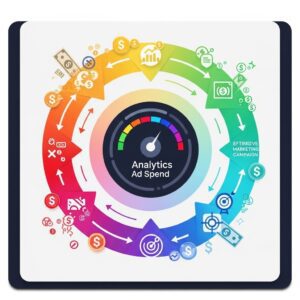Apply For Scholarship
Apply For Scholarship
Running ads isn’t enough anymore. If you’re not analyzing performance, you’re wasting budget. That’s where advertising analytics comes in.
These tools help you track what’s working, fix what isn’t, and make smarter decisions with your ad spend.
Whether you’re managing a few campaigns or dozens across multiple platforms, analytics gives you the insight to improve results faster and maximize ROI.
This guide by NDMIT – one of the top digital marketing institutes in India—breaks down how advertising analytics works, what metrics matter, the tools worth using, and how to turn data into better outcomes


Advertising analytics examines the performance of marketing campaigns across platforms. It uses data to measure success, understand target audiences, and optimize future efforts.
By analyzing campaign data, businesses can discover what’s effective, what’s not, and how to adjust strategies for better outcomes.
1.Improved Decision-Making
89% of top marketers use analytics to track key metrics like revenue and market share. With the right insights, businesses can confidently choose winning strategies and cut down wasted efforts.
2. Enhanced Targeting
Predictive analytics and customer behavior data help marketers deliver messages to the right audience. With 70% of consumers influenced by online reviews, analytics ensures ads resonate with the right people.
3. Cost Efficiency
Why waste money? Analytics highlights which campaigns perform best, letting you optimize budget allocation and reduce CPCs.
4. Increased ROI
Marketers who integrate AI with analytics see up to a 70% ROI boost. Data-driven adjustments ensure consistent growth and profitability.
5. Better Customer Insights
Nearly 50% of internet users are influenced by influencers. Analytics reveals customer interests, preferences, and behaviors—fueling more personalized campaigns.
Think of it as piecing together a puzzle: data flows in from Google Analytics, social media platforms, and ad managers. Advanced tools then organize and interpret this information into actionable insights.
The result? A clear roadmap showing what works and what needs fixing. This ongoing analyze → optimize → repeat cycle is why advertising analytics is a core skill taught at NDMIT’s Digital Marketing program.

Understanding the right metrics is what separates average marketers from data-driven digital leaders. Let’s explore the most important ones:
1. Click-Through Rate (CTR)
2. Conversion Rate (CR)
3. Ad Spend
4. Return on Ad Spend (ROAS)
5. Customer Acquisition Cost (CAC)
6. Average Order Value (AOV)
7. Cost Per Click (CPC)
8. Impressions
9. Engagement Rate
10. Lifetime Value (LTV)
11. Cost Per Acquisition (CPA)
12. Cost Per Lead (CPL)
13. Cost Per Thousand Impressions (CPM)
14. Cost Per Engagement (CPE)
15. Cost Per View (CPV)
The right tools can make all the difference between guesswork and data-driven marketing success. Advertising analytics tools allow businesses to track performance, measure ROI, and understand audience behavior with precision. Below are some of the most powerful and widely used tools that every marketer should know:
1. Google Analytics
Google Analytics is one of the most essential tools for measuring online marketing performance. It provides deep insights into:
By integrating Google Ads and other platforms, marketers can see how different campaigns impact overall website performance. It’s particularly valuable for tracking customer journeys from the first ad click to final purchase.
3. Google Ads
Google Ads provides powerful analytics for businesses investing in search and display advertising. It offers:
Real-time performance tracking at the keyword and campaign level.
Data on clicks, impressions, CPC (cost per click), and conversions.
ROI measurement to evaluate ad spend effectiveness.
Marketers can adjust bidding strategies, refine targeting, and discover the most profitable keywords, making it a must-have for PPC campaigns.
5. HubSpot
HubSpot is more than just a CRM—it’s a complete marketing automation platform. It allows you to:
Track ad campaigns, email performance, and social media in one place.
Understand how ads contribute to leads, sales, and customer journeys.
Generate detailed reports linking ad spend to ROI.
HubSpot’s strength lies in combining advertising data with CRM insights, helping businesses see the full picture of customer acquisition.
7. Tableau / Power BI
Both Tableau and Microsoft Power BI are data visualization tools that turn complex ad data into interactive dashboards. They allow marketers to:
Connect multiple data sources (Google Ads, Facebook, HubSpot, etc.).
Build visual reports that highlight performance trends.
Share insights with decision-makers in an easy-to-understand format.
These tools are vital for businesses managing large datasets and needing clear, visual insights for strategy.
9. Mixpanel
Mixpanel is ideal for SaaS companies and app-based businesses. It specializes in event-based tracking, showing how users engage with digital products. Key features include:
Tracking user actions such as clicks, downloads, or in-app purchases.
Identifying high-value users through behavioral analytics.
Measuring the impact of ads on long-term app engagement.
For businesses in the digital product space, Mixpanel is a game-changer.
2. Facebook Ads Manager
For businesses running campaigns on Facebook and Instagram, Ads Manager is the go-to platform. It enables marketers to:
Create, manage, and optimize ad campaigns.
Access detailed analytics such as impressions, CTR, and engagement.
Use A/B testing to compare ad creatives and targeting options.
Its biggest strength lies in offering audience insights—helping businesses understand which demographics and interests engage the most.
4. Camphouse
Camphouse is a dashboard and visualization tool designed to manage multi-channel campaigns in one place. Key benefits include:
Customizable dashboards showing KPIs from multiple ad platforms.
Real-time performance monitoring across campaigns.
Easy-to-schedule reports that can be shared with teams and clients.
This tool is especially useful for marketing agencies or businesses juggling ads across multiple platforms simultaneously.
6. SEMrush
SEMrush is a popular competitive analysis tool for marketers who want to stay ahead. With SEMrush, you can:
Track your own ads’ performance alongside competitors’.
Discover keywords your competitors are bidding on.
Analyze ad copy effectiveness and benchmark performance.
It’s especially powerful for businesses running search ads, as it helps uncover untapped opportunities.
8. Kissmetrics
Kissmetrics focuses on customer behavior analytics. Unlike tools that only show campaign data, Kissmetrics provides:
Insights into how individual users interact with ads.
Funnel analysis to see where customers drop off.
Cohort analysis for long-term tracking of customer behavior.
It’s excellent for understanding what drives conversions and improving customer retention.
10. Hotjar
Although not a traditional ad analytics tool, Hotjar is invaluable for understanding user behavior on landing pages. It offers:
Heatmaps showing where users click and scroll.
Session recordings to see exactly how visitors interact with a page.
Conversion funnel tracking to identify where users drop off.
Advertising analytics is no longer optional—it’s the backbone of modern digital marketing. From CTR to LTV, the right metrics help businesses optimize campaigns, improve targeting, and achieve higher ROI.
At NDMIT – one of the best digital marketing institutes, students master these analytics tools and strategies, preparing them to become future-ready digital marketers who don’t just run ads but analyze, optimize, and win with data.
Advertising analytics is the process of tracking, measuring, and analyzing the performance of ad campaigns across platforms like Google, Facebook, Instagram, and more. It helps businesses understand what’s working, identify underperforming ads, and optimize campaigns for better ROI. Without analytics, ad spend often goes to waste because decisions are made on assumptions rather than real data.
👉 At NDMIT, we train students and professionals to use advertising analytics effectively, covering key metrics like CTR, ROAS, CPC, and advanced tools like Google Analytics, HubSpot, and Facebook Ads Manager
Advertising analytics directly impacts ROI by showing which campaigns generate the most conversions and which ones drain your budget. By reallocating spend towards high-performing ads, refining audience targeting, and leveraging data insights, businesses can significantly improve ROI.
👉 In NDMIT’s Digital Marketing & Data Analytics programs, we teach hands-on methods to measure ROI, optimize ad performance, and apply predictive analytics for smarter campaign decisions.
Some of the most in-demand advertising analytics tools include:
👉 At NDMIT, we provide practical training on these industry-standard tools, preparing students to confidently manage real-world ad campaigns.
Analytics helps uncover audience behavior, demographics, and engagement patterns. By analyzing this data, marketers can create laser-focused campaigns, target the right people at the right time, and deliver ads that resonate with customer interests. This prevents wasted impressions and improves click-through rates.
👉 NDMIT’s curriculum emphasizes audience segmentation, predictive analytics, and behavioral targeting—skills that top digital marketers use daily to craft high-converting campaigns.
NDMIT is one of the top digital marketing institutes in India, known for its industry-relevant curriculum, NSDC-accredited certification, and 100% placement support. Learning advertising analytics at NDMIT means you won’t just understand theory—you’ll gain hands-on experience with real tools, live projects, and case studies.
By the end of the program, you’ll be able to:
👉 If you want to master advertising analytics and digital marketing, NDMIT is the best place to start your journey.
Asia’s Leading Digital Marketing & Data Science Institute
A comprehensive methodology with the best curriculum, designed according to current corporate demands and needs.
Copyright © NDMIT Edusoft Private Limited